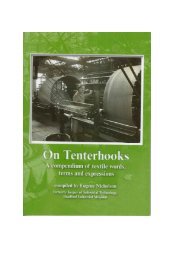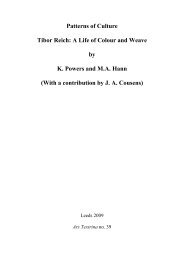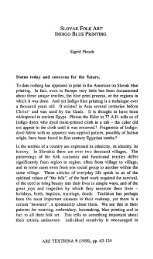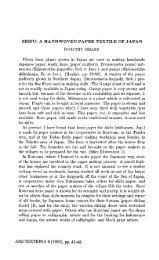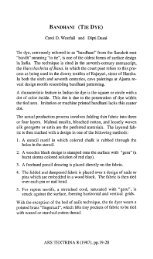Decorative Weaving Techniques - International Textiles Archive ...
Decorative Weaving Techniques - International Textiles Archive ...
Decorative Weaving Techniques - International Textiles Archive ...
You also want an ePaper? Increase the reach of your titles
YUMPU automatically turns print PDFs into web optimized ePapers that Google loves.
40<br />
caused through competition from drawlooms. Large multiple-heddle<br />
looms may well have presented a challenge to operate, even for a highly<br />
skilled weaver, but such looms eliminated the need for the services of the<br />
weaving assistant and allowed more rapid production [Hilts, 1990a,<br />
pp.25-32]. A comprehensive explanation of the operation of various<br />
drawlooms was given by Murphy [1837] and a more recent description<br />
of historical developments in drawloom weaving was given by Becker<br />
[1987] one hundred and fifty years later.<br />
In 1805 Joseph Marie Jacquard (1752-1834) presented an automatic<br />
selection mechanism which could be mounted on a raised horizontal<br />
loom and operated by a treadle. This device was to revolutionise pattern<br />
weaving. A series of perforated cards, connected in the form of an<br />
endless chain, was presented one at a time to the selection mechanism.<br />
Depending on the order of the perforations in each card, certain warp<br />
threads were raised to form a shed and this shed corresponded to a stage<br />
within the predetermined pattern. Schaefer pointed out that by the year<br />
1812 an estimated 18,000 looms were fitted with the mechanism, and by<br />
1834 this had risen to 30,000, data which clearly attest the success of the<br />
innovation [Schaefer, 1938, p.564]. A comprehensive explanation of the<br />
operation of the Jacquard mechanism was given by Watson [1954,<br />
chapters 14 and 15].<br />
4.8 Dobby loom<br />
From the later stages of the Industrial Revolution until the late-twentieth<br />
century, dobby (power) looms served in producing the vast bulk of basic<br />
woven textiles world wide, in all industrialised countries. Hand-operated<br />
dobby looms were popular with hand loom weavers throughout much of<br />
the twentieth century. This class of loom had a series of wooden or<br />
aluminium frames (known as shafts or heddles), each the width of the<br />
warp. Each heddle held a series of vertical wires and each wire had one<br />
or more eyelets. Each warp thread was drawn through one of these<br />
eyelets on a selected heddle. The order in which the threads were drawn<br />
through the eyelets in the series of heddles was known as the draft. The<br />
loom was programmed so that prior to each weft insertion a particular<br />
selection of heddles and thus a particular selection of warp threads was<br />
lifted to form a shed. Typically each shed selection was determined by<br />
presenting a row of metal pegs to a selection mechanism located between<br />
a metre and a metre and a half above the warp. This selection mechanism



